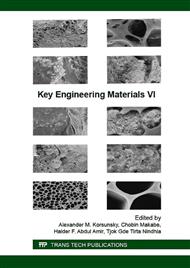p.186
p.190
p.199
p.204
p.209
p.214
p.219
p.227
p.233
Viscosity and Density of Co-B Liquid Fusions
Abstract:
Kinematic viscosity and density of cobalt liquid alloys with boron is studied. Range of boron concentration was from 1 to 8 mass percent. The chemical composition of real industrial alloys is in limits of this range of concentration. Viscosity and density measurements of all samples are taken in a wide temperature interval. Measurements of viscosity are taken by method of torsional fluctuations of a crucible with fusion. Measurements of density are taken by method of a sessile drop. Existence of density data significantly increased the accuracy of processing of experimental data of viscosity. It is revealed that kinematic viscosity can be different at one and same chemical composition of an alloy. It is established that upon transition through the eutectic concentration of boron, nature of viscosity dependences from temperature of a liquid alloy changes. The explanation option of the found regularities is offered.
Info:
Periodical:
Pages:
209-213
Citation:
Online since:
August 2016
Price:
Сopyright:
© 2016 Trans Tech Publications Ltd. All Rights Reserved
Share:
Citation:


